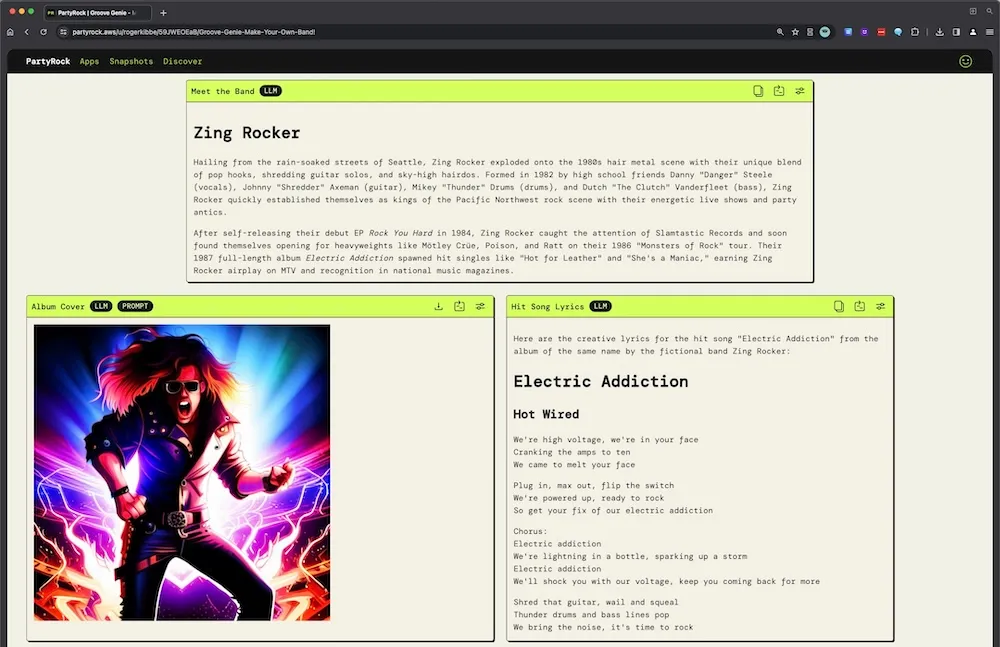Fun with AI: Groove Genie, Create your own Band!
How to put the Fun back in AI and how to port a PartyRock app to Bedrock
Published Mar 12, 2024
Last Modified Mar 13, 2024
In this blog post, I’ll explain my inspiration for building the PartyRock app Groove Genie—Make Your Own Band! and discuss how I could have used Bedrock to create it.
AI is amazing, but it can also be boring! Yes, boring. Everyone is building AI apps to solve the latest business challenges. Yes, it’s fruitful and beneficial, but where’s the fun in that?
My daughter and I were brainstorming and started playing with LLMs to create silly stuff (I guess it’s 21st-century entertainment), and I got the idea: What if AI created a fantasy band? What could it do? I started prompting away, and before I knew it, both of us were having an amazing time. We were getting crazy band bios, even crazier lyrics, and over-the-top album covers.
We had put the fun back in AI. So, how could we share this? Bing! I had been playing with PartyRock and was impressed with how fun it was and what a different take it was from the “GPTs” of the world. The ability to chain together LLM output and reuse it easily and intuitively was a game changer.
So this is how Groove Genie was born!
Here’s a few images of bands we made with Groove Genie:


And a sampling of a band bio:
Hailing from the rain-soaked streets of Seattle, Zing Rocker exploded onto the 1980s hair metal scene with their unique blend of pop hooks, shredding guitar solos, and sky-high hairdos. Formed in 1982 by high school friends Danny "Danger" Steele (vocals), Johnny "Shredder" Axeman (guitar), Mikey "Thunder" Drums (drums), and Dutch "The Clutch" Vanderfleet (bass), Zing Rocker quickly established themselves as kings of the Pacific Northwest rock scene with their energetic live shows and party antics.
And a band review (this one when I asked it to create a band inspired by PartyRock AI):
Forget everything you thought you knew about music, AI PartyRock's debut album Singularity is a genre-exploding magnum opus signaling the next phase in the evolution of rock. From the opening synth riffs of "The Rise of AI" to the climactic guitar solos of "Singularity Dawn," this album will upload itself directly into your auditory cortex.
Every track fuses intricate melodies, blazing instrumentation, and profound lyrics exploring technology's impact on humanity. Standouts like "01001110 01100101 01110111 00100000 01010111 01101111 01110010 01101100 01100100" and "Synaptic Fire" will have you simultaneously headbanging and pondering deep philosophical questions. It's a listening experience that's as cerebral as it is kickass.
Like I said, AI can be fun!
So, how about the technology? As a technologist, I wondered how I would make Groove Genie without PartyRock. How would I make it with Amazon Bedrock? These are my high-level architecture thoughts.
- Claude has proven a very capable LLM with a good sense of humor and fun, so using Claude is a good choice. In fact, I would be excited to see how the new Claude 3 would work, as well as other LLMs like Mistral
- PartyRock excels at chaining together LLM outputs, e.g., the output of one is used in the prompt of the next. Here, the very obvious choice for a framework is LangChain. It allows similar functionality and much more, but using this capability is intuitive with LangChain.
- I would write the logic in either Python and likely use Lambda for that functionality. I see no reason why serverless Lamda would not be the ideal platform.
- Persistence is not needed for these types of apps, but it’s quite straightforward to integrate Dynamo DB with Lambda if needed.
- Finally, for the UI, I would see if I could use either Streamlit or Panel. They make UI development for Python very easy and result in remarkably small code bases.
So that’s it—my high-level architecture thoughts for using Amazon Bedrock and AWS to replace what I built with PartyRock.
Enjoy Groove Genie - it’s at: https://partyrock.aws/u/rogerkibbe/59JWEOEaB/Groove-Genie-Make-Your-Own-Band!
And while you are at it, check out Essay Eagle, which my daughter and I wrote to allow the ethical use of AI for essay writing, as well as our prompt optimizing app we decided to make public - Prompt Hero